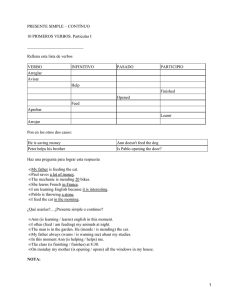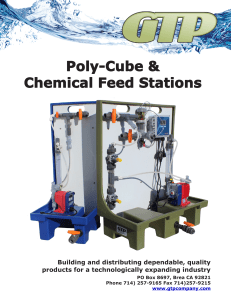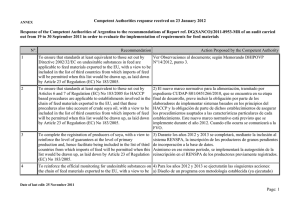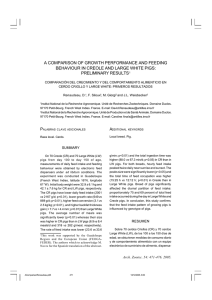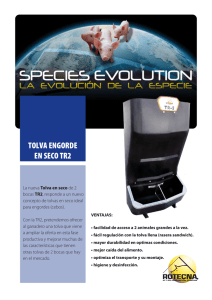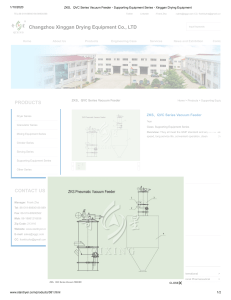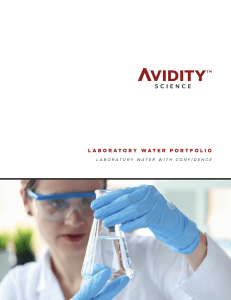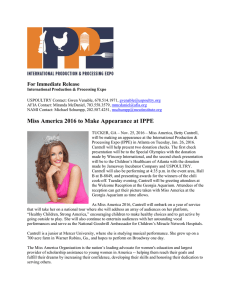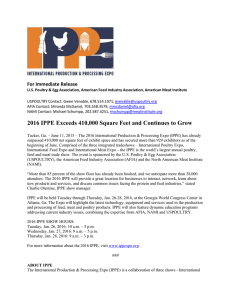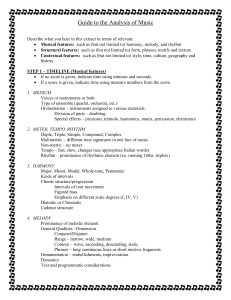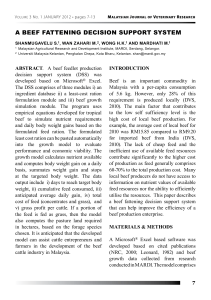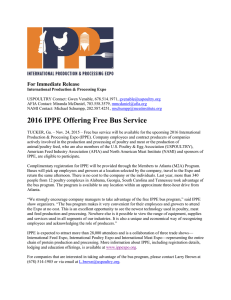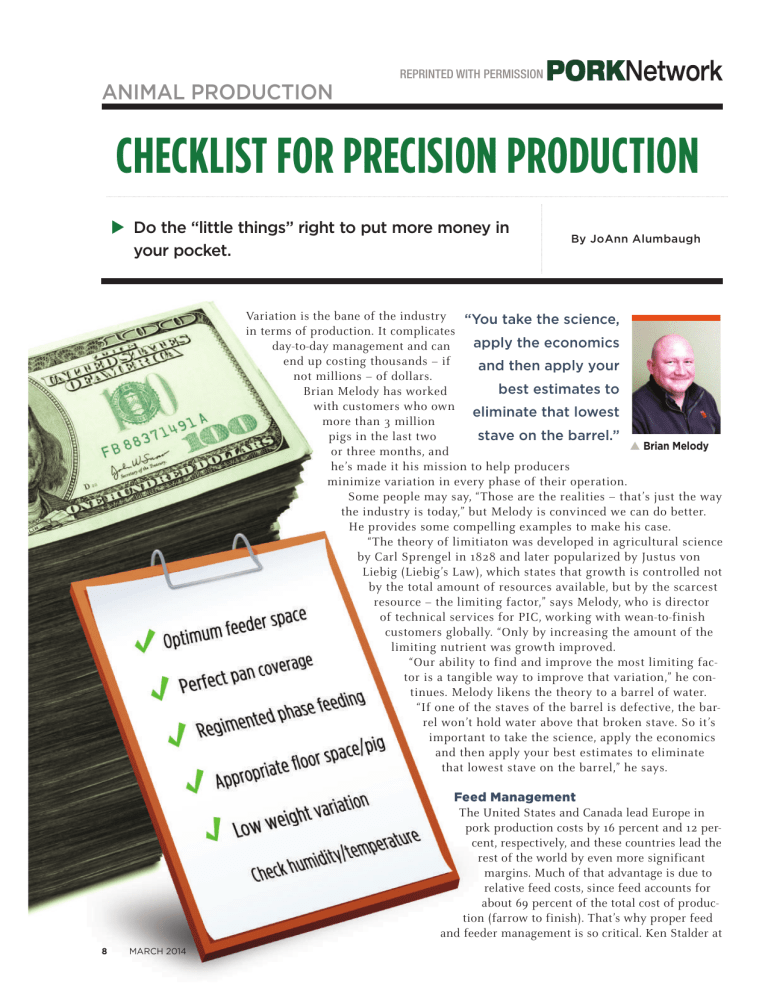
Animal Production Reprinted with permission Checklist for Precision Production Do the “little things” right to put more money in your pocket. By JoAnn Alumbaugh Variation is the bane of the industry “You take the science, in terms of production. It complicates apply the economics day-to-day management and can end up costing thousands – if and then apply your not millions – of dollars. best estimates to Brian Melody has worked with customers who own eliminate that lowest more than 3 million stave on the barrel.” pigs in the last two p Brian Melody or three months, and he’s made it his mission to help producers minimize variation in every phase of their operation. Some people may say, “Those are the realities – that’s just the way the industry is today,” but Melody is convinced we can do better. He provides some compelling examples to make his case. “The theory of limitiaton was developed in agricultural science by Carl Sprengel in 1828 and later popularized by Justus von Liebig (Liebig’s Law), which states that growth is controlled not by the total amount of resources available, but by the scarcest resource – the limiting factor,” says Melody, who is director of technical services for PIC, working with wean-to-finish customers globally. “Only by increasing the amount of the limiting nutrient was growth improved. “Our ability to find and improve the most limiting factor is a tangible way to improve that variation,” he continues. Melody likens the theory to a barrel of water. “If one of the staves of the barrel is defective, the barrel won’t hold water above that broken stave. So it’s important to take the science, apply the economics and then apply your best estimates to eliminate that lowest stave on the barrel,” he says. Feed Management The United States and Canada lead Europe in pork production costs by 16 percent and 12 percent, respectively, and these countries lead the rest of the world by even more significant margins. Much of that advantage is due to relative feed costs, since feed accounts for about 69 percent of the total cost of production (farrow to finish). That’s why proper feed and feeder management is so critical. Ken Stalder at 8 March 2014 AnimAl ProDuction Iowa State University did a Pork Industry Productivity Analysis of closeouts last year, and found significant differences between the top 10 percent, the average and the lowest 25 percent in a number of production parameters, including feed conversion (See Figure 1). These numbers represent individual herds, so it speaks to the variation that continues to impact the industry. Between the bottom 25 percent and the average for wean-to-finish feed conversion, there was a difference of 77.16 lbs. of feed, and between the top 10 percent and the average, there was a difference of 55 lbs. of feed. On a per-pig basis, think of how that variation can add up within an operation. Figure 2 further illustrates the opportunity cost related to variation in feed conversion. This study was in one operation with 322,000 pigs. “This system has a range from 2.3 to 3.4 in F:G,” says Melody. “The poorest pig performance utilized 242 more lbs. of feed than the best, which equates to $29.04 added cost. In addition, the average closeouts utilized 92.4 more lbs. of feed than the best. That’s $11.09 per pig, or$3.57 million in opportunity cost. That’s money that could be going into the producer’s pocket.” Efficiency Impacted by Feeder and Floor Space Steve Jungst and the product validaion team at GenusPIC have done extensive research on the correct floor space and feeder space needed to maximize production. He looked at three different stocking levels and three different feeder-space measurements. The pens had 190.15 total sq. ft. of floor space and 5.83 sq. ft. of floor space for feeders, for 184.32 net sq. ft. of floor space. The initial stocking densities were: • 23 Pigs/Pen (8.02 net sq. ft./pig) • 26 Pigs/Pen (7.09 net sq. ft./pig) • 29 Pigs/Pen (6.36 net sq. ft./pig) Take a look at Figure 3 (page 10) and one can easily see that more is not necessarily better. In fact, for this study, the optimum return based on margins above feed and Figure 1 housing was 7 sq. ft./pig and 2.15 in. of feeder space. “Using a fixed weight basis, the return on investment for new feeders to meet the recommended level could make up the cost of the feeders in one year (provided the other variables stay the same),” says Melody. “If constraints cause producers to sell pigs at lighter weights, each pound would be a productivity loss Wean-to-Finish Feed Conversion Stalder, K. 2013. Pork Industry Productivity Analysis. Figure 2 Variation Management Genus PIC, 2013 › This system has a range from 2.3 to 3.4 in F:G › The poorest pig performance utilized 242 more lbs. of feed than the best ($29.04 added cost) › Average closeouts utilized 92.4 more lbs. of feed than the best ($11.09 or $3.57 million in opportunity cost) PORKNetwork 9 Animal Production Pan Coverage Effects “We reviewed 42 trials to measure pan coverage effects, and the dollars really add up,” says Melody. “A .10 change in feed conversion represents 25 lbs. of feed. If a pig takes 180 days to go to market, that would mean they’re wasting .14 lbs. of feed per day. That’s worth $3.25 per pig over its lifetime. The rule is every day, every pen, every feeder/pig.” If you have a picture of the pan coverage, it helps you and/or your employees know what to look for. Feed Availability “Feeder capacity is one of the largest limiting factors that can compromise the cornerstone to production,” says Melody. Feed outages have a significant impact on growth rate and efficiency, so any actions that can be taken to minimize these events is critical. The company’s recommended feeder capacity serves the following purposes: • Assurance of 24 hours of feed available within the barn to each individual; automated feed systems have improved labor efficiency within modern swine growing facilities; however they are not infallible. • Timely detection of maintenance issues within the feed system without compromising feed availability • Ability to effectively transition between diets and feed for changes without blending. • Improvement of feed flow from outside bins due to the large volumes of feed removed during each filling cycle • Availability of feed to pigs during peak intake hours, which will vary seasonally • Minimization or elimination of hemorrhagic bowel syndrome, 10 March 2014 This pan is 79 percent covered: this is too much feed and wastage will be high. This is the correct amount of feed you should see in the pan (40 percent). At nine percent coverage, this is too little feed in the pan. Photos by Kansas State University of $.30/lb., given today’s economics on the open market.” Given ideal feeder space, the next factor to consider is pan coverage. Margins above Feed and Housing, $ Figure 3 $20.00 $17.50 $18.00 $16.00 $14.00 $15.05 $13.35 $13.48 $12.00 $13.44 $10.12 $10.00 $8.00 $6.00 8 Sq Ft & 1.22 in. Feeder 7 Sq Ft & 1.07 in. Feeder 6.36 Sq Ft & .096 in. Feeder 8 Sq Ft & 2.43 in. Feeder 7 Sq Ft & 2.15 in. Feeder 6.36 Sq Ft & 1.93 in. Feeder Genus PIC, 2013 ulcers, and tail-biting, often triggered by out-of-feed events • Feed-ordering pattern aligned with predictable daily feed intake It’s All About the Details There are many other factors that impact production profitability, like temperature and humidity, water availability, genetics, phase feeding regimens, health, morbidity/mortality rates, etc., and we will look at those factors in an upcoming issue of PorkNetwork. What is clear, however, is that all these little details add up to significant dollars, and taking a more direct, systematic approach to monitoring production will yield significant dividends. “This process is only a year old but customers are very positive about it on implementation,” says Melody. “If we can focus on the bottom 10 percent in terms of challenges, it has the potential to create significant savings for an operation, regardless of size.” PN OUR STRONGEST TRAIT IS YOUR SUCCESS Making the move to PIC is the fastest way you can increase your operation’s efficiency. PIC products can deliver: Faster growth to market weight More full value market pigs Better feed conversion Increased productivity and greater margin Industry-leading technical services and customer support www.pic.com/usa 100 Bluegrass Commons Blvd. Ste 2200. Hendersonville, TN 37075 1-800-325-3398 ©2014 PIC All Rights Reserved.
